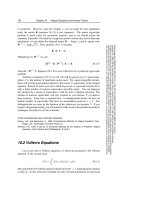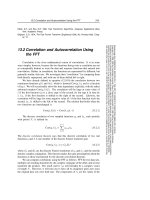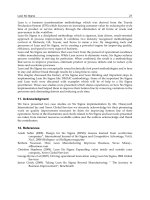Modular Tooling and Tool Management Part 3 ppt
Bạn đang xem bản rút gọn của tài liệu. Xem và tải ngay bản đầy đủ của tài liệu tại đây (690.04 KB, 10 trang )
Figure 126. Milling cutter toolholder taper tment. [Courtesy of Sumitomo Electric Hardmetal Ltd.].
Modular Tooling and Tool Management
Figure 127. HSK high-speed modular tooling, for machining applications on turning/machining centres. [Courtesy of Guhring].
Chapter
thus signicantly minimising any potential surface
wear.
ese major tooling advantages for the HSK-type
tooling design, has shown a wide adoption by compa-
nies involved in high-speed machining applications,
throughout the world today. In the following section,
a case is made for tool-presetting both ‘on’ and ‘o’
the machine tool, with some of the important tooling
factors that need to be addressed. e problems asso-
ciated with tool-kitting and the area for undertaking
such activities will be discussed, in order to ensure
that the tools are eciently and correctly assembled,
then delivered to the right machine tool and at the
exact time required – this is the essence of successful
‘Tool management’.
6.5 Tool Management
Introduction
Manufacturing industries involved in machining
operations encompass a wide variety of production
processes, covering an extensive eld of automation
levels. Not only will the cost of investment vary from
that of simple ‘stand-alone’ CNC machine tools, to
that at the other extreme: a Flexible Manufacturing
Systems (FMS), but other factors such as productivity
and exibility play a key role in determining the tool-
ing requirement for a particular production environ-
ment (Fig. 128). Each machine tool, operating either
in isolation (ie. in a ‘stand-alone’ mode), or as part of a
manufacturing cell/system, needs specic tooling (i.e.
tool kits) to be delivered at prescribed time intervals.
Such tooling demands are normally dictated by the de-
vised sequence of production from some ‘simple’ form
of manufacturing requirement, to that of a highly so-
phisticated computerised ‘Master Production Sched-
ule’ (MPS).
With the introduction of CNC machine tools in
the late 1970’s, the drive has been towards smaller
batch sizes, this has meant that some form of tool
management has become of increasing importance in
machining operations, in order to keep down-time
16
to a minimum. In an USA survey of tooling activities
conducted some years ago into manufacturing compa-
nies involved in small-to-medium batch production
using CNC machine tools, the tooling requirements
and scheduling le a lot to be desired, in terms of ef-
cient tool management – verging in some cases, on
the chaotic! In Fig. 129 the diagram depicts the typi-
cal ‘re-ghting’ concerned with this lack of tooling
availability, highlighting the tool problems that were
found. Here (Fig. 129), the diagram illustrates the
actual time-loss constituents – in % terms, clearly
showing that ‘line-management’ and operators spent
considerable time and eort trying to nd tools in
the machine shop, or were simply looking for tools
that did not exist! is chaotic state of aairs, meant
that highly-productive machine tools were idle, while
this ‘self-defeating activity’ was in progress. With the
actual machine tool running costs being so high, this
remedial action was somewhat futile and cost these
companies considerable nancial encumbrance, that
would be dicult to estimate – in real terms. Today,
some of these problems are still apparent in many
machine shops throughout the world, so the tooling
problems mentioned here are still valid. Had some
form of ‘simple’ tool management system existed
within these companies, then many, if not all of these
tooling-related problems would have been eliminated.
is fact was also conrmed in this tooling survey,
by some of the more ‘enlightened’ companies that
utilised tool management, either operating at the most
elementary level, to that of a highly sophisticated com-
puterised system, that encompassed: total tool control:
servicing, presetting, delivery of kits, replenishment
of tooling stock levels and monitoring of tooling and
its utilisation level within the production operation in
the machine shop. It is not unreasonable to assume,
that tooling inventories can be vast within a relatively
moderately-sized machine shop (i.e. see Fig. 130 as it
visually indicates the problem of keeping some form
16 ‘Down-time’ , refers to the non-productive time that occurs
when the machine tool is not actually involved in any machin-
ing operations. is ‘down-time’ might be the result of a range
of individual, or inter-related factors, such as: unexpected ma-
chine tool stoppages, changing and adjusting tooling, setting-
up the xtures/jigs/pallets, planned maintenance, or tools that
are simply not available for the machine tool when they are
needed!
Modular Tooling and Tool Management
of control of the tooling). Not only is keeping track of
individual tools and their identication, tool-building,
presetting and kitting, together with other tooling-
related problems, becoming an almost impossible task,
particularly when this is exacerbated by companies
attempting to run a JIT
17
philosophy, coupled to that of
an MRPII
18
production scheduling operation.
In the past and, for many ‘traditional’ CNC produc-
tion environments, any form of ‘tool management’ was
generally the province of the machine tool operator.
So, alongside each machine would be situated a limited
kit of tools, these being maintained and replenished
with spares and consumables, via the operator’s liaison
with the tool stores. Hence, a skilled setter/operator’s
main tooling responsibility was to select the correct
tooling, then devise cutting techniques and utilise the
appropriate machining data necessary to eciently cut
the parts. is ‘working-situation’ enabled a process
planner, or part-programmer to treat the machine tool
and operator plus the tool-kit, as a single, ‘self-main-
taining system’ – with a well-established performance.
Such production circumstances, allowed work to be
allocated to specic machine tools, whilst leaving the
detailed cutting process denitions: tool osets, tool
pocket allocation, tooling cutting data (i.e. relevant
speeds and feeds), coolant application, machining op-
erational sequencing, etc., to that of the operator’s pre-
vious skills and knowledge.
17 ‘JIT’ , refers to the manufacturing philosophy of ‘Just-in-time’ ,
where the system was developed in Japan (Toyota – in the
main), to ensure a philosophy and strategy occurred to mi-
nimise time and production wastages. e JIT policy has es-
sentially six characteristic elements, these are:
(i) Demand call – the entire manufacturing system is ‘led’ , or
‘pulled’ by production demands,
(ii) Reduction in set-ups and smaller batches – minimises
time-loss constituents and reduces WIP*,
(iii) Ecient work ow – thereby high-lighting potential ‘bot-
tlenecks’ in production, *work-in-progress (WIP) levels,
(iv) Kanban – this was originally based on a ‘card-system’ for
scheduling and prioritising activities,
(v) Employee involvement – using their ‘know-how’ to solve
the ‘on-line’ production problems,
(vi) Visibility – ensuring that all stock within the facility is
visible, thereby maintaining ‘active control’.
18
‘MRPII’ , Manufacturing Resource Planning (i.e. was devel-
oped from MRP) – essentially it is a computer-based system
for dealing with planning and scheduling activities, together
with procedures for purchasing, costs/accounting, inventories,
plus planned-maintenance activities and record-keeping.
Today, with the increasing diversity of work that
can be undertaken on the latest CNC machine tools,
which has occurred as a result of the exibility of
manufacturing in conjunction with reductions in eco-
nomic batch quantities, this has change the pattern of
working. In order to cope with such work diversity,
some ‘stand-alone machine tools’
19
have acquired a
very large complement of tools. However, a situation
soon develops in which neither the operator, nor the
part-programmer is suciently in control to accept
responsibility for the range of tooling dedicated to any
specic machine tool
20
. So, as a result of a full-deploy-
ment of CNC machine tools, the production organi-
sation related to tooling applications, would normally
change to one in which:
•
e production process is dened separately – be-
ing remotely situated from the shop oor,
•
Machining programs and associated tool list are
produced – these being sent down to both the ma-
chine tool and tool-kitting area via a suitable ‘DNC-
link’
21
, with all of the process data and tooling ‘fully-
dened’.
NB ere may be some element of doubt concern-
ing the quality of the tooling denition and even
the cutting data produced when the part was origi-
nally programmed.
•
Batch sizes become smaller – the operator is under
increasing pressure to run the given program with-
out alteration, which leads to ‘conservative cutting’
resulting in less-than-optimum machining,
•
Machine operator runs the program with the
minimum of alteration – this means that the ‘ne-
tuning’ of the operator’s past experiences are not
19 ‘Stand-alone machine tools’ , is a term that refers to highly-
productive CNC machines that are not part of an automated
environment, such as either, a exible manufacturing cell, or
system (FMC/S).
20 If the company has
not purchased a computer-aided manufac-
turing (CAM) so-/hard-ware system, then it will not be in a
position to take full advantage of the complex aids for tool-
ing-selection criteria available with many of the more sophis-
ticated CAM systems now currently available.
21 ‘DNC-link’ , is a term that refers to the direct numerical con-
trol, this being associated with a shared computer for the dis-
tribution of part program data, via data lines to remote CNC
machine tools and other CNC equipment in a system.
Chapter
Figure 128. A comparison of manufacturing systems based upon the following criteria: automation level, productivity and in-
vestment costs. [Courtesy of Scharmann Machine Ltd.]
.
utilised, thereby creating ineciencies in part cycle
times.
ese factors, make the whole operation critically de-
pendent on the ability of the tool-kitting area to sup-
ply and support the part programmer’s specic tooling
requirements. is is an unsatisfactory and ineective
tool-management system, with the major problem be-
ing that there is no feed-back of experiences gained
from machining specic components, which is obvi-
ously undesirable. is situation results in the part
programmer being oblivious to any problems encoun-
tered during component machining, causing a further
lack of awareness in the tool-kitting area, producing a
critical loss of tool management support.
To minimise the problems associated with the lack
of information received by the part programmer and
the tool-kitting area, feed-back can be established from
the operators, which can be for the whole shop, or for
each section of machines. Normally, a centralised sys-
tem based around an appropriate tool le is essential,
this activity in turn, would usually be controlled and
managed by a le editor. e tool le can be either a
manual-, or computer-based system, but will in gen-
eral, be accessible to the following personnel: process
engineer, part programmer, machine operator, tool
stores sta, le editor and management, as necessary –
with certain levels of access-codes allowing some form
of tooling interrogation (i.e. for security reasons). A
typical tool le must contain all the information rel-
Modular Tooling and Tool Management
Figure 129. A cutting tool survey of companies in the USA – illustrating the tooling ‘re-ghting’
solutions on the shop oor. [Courtesy of Kennametal Inc.]
.
Chapter
Figure 130. An ecient tool management system is vital if a company is to eectively monitor and control its supply to their
production machining facilities. [Courtesy of Sandvik Coromant]
.
Modular Tooling and Tool Management
evant to the needs of all the relevant personnel con-
cerning every tool available – more will be said on this
topic later.
.. The Tool Management
Infrastructure
Whenever a tool management system has been devel-
oped, an organised and well-planned tool preparation
facility is vital to prepare the specic tooling require-
ments – o-line, so that tooling might be:
•
Built to pre-dened assemblies – from a range of
standardised stocked parts, or from tool modules,
•
Replacing worn cutting inserts on used tooling as-
semblies – these tools being returned for rebuild-
ing, or servicing,
•
Measuring tool osets – then, when it is both
timely and appropriate, sending tooling in the form
of tool-kits to specied machine tools,
•
Inspecting tooling – normally undertaken on tool
pre-setters and by visual means, to ensure that they
are t for immediate use,
•
Assembling: tooling, xtures, gauges, etc., as a
‘complete tool-kit’ – to be issued to the appropriate
machine tool at the correct time.
In order to ensure that consistent and accurate tool
preparation occurs, a documented ‘historical proce-
dure’ covering all tooling-related aspects, is necessary,
such as: tool inspection, servicing and building, is re-
quired for each tool. ese factors can be controlled
by utilising a computerised tool management system,
as only the data les will need to be updated, together
with tooling assembly instructions, with both servic-
ing and inspection being undertaken by a step-by-step
approach – if needed. Many of the more sophisticated
tool management systems currently available, oer
a link back to the original Computer-aided Design
(CAD) soware, allowing tools to be shown graphi-
cally assembled as tool parts.
As the these tools travel around the machining
facility, through various stages of preparation and
measurement, then assembled as ‘qualied tool-kits’
visiting machine tools and then travelling back to
the tool preparation area for re-servicing, each stage
of the tool-kit’s cycle must be controlled. Informa-
tion concerning the tool kit’s progress, must be avail-
able at any instant and, a means of exercising control
is to link each tooling station to a central computer
via a DNC-link. As the unique data referring to any
tool is stored within the central computer, its identity
can be accessed allowing its ‘logistical progress’
22
to be
precisely tracked within the manufacturing facility.
For some companies that are unable to justify such a
complex tool management method of tooling control,
then a much less costly and simpler ‘manual system’
using either printed labels, or bar-codes can be de-
ployed for tool identication when delivering tooling
to-and-from the required machine tool. A cautionary
note concerning the use of paper labels for tool identi-
cation, is that they can more easily become detached
during the machining cycle.
In an automated machining environment, there is
no real alternative but to have a ‘tooling requirement’
and in particular, employing some form of ‘intelligent/
tagged’ tooling, typically via permanent machine-
readable tool identication. Such tool identication
techniques, allow the necessary data to be interrogated
and retrieved from critical areas around the produc-
tion facility: machine tools, preparation area and stor-
age, plus other peripheral areas – as required. Tooling
equipped with ‘intelligent’ memory circuits embed-
ded within them (i.e. typically shown in the case of
the non-rotating ‘Block tooling’ in: Figs. 116, 117 and
118), can automatically perform the functions of: tool
identication, tool osets and cutting data up-dating
on the machine tool. Other information complement-
ing the tooling data-base pertaining to tool servicing
needs can also be exploited by using these ‘tool-coded
data chips’ , which are securely situated within the
‘front-end’ of each tool.
So that ‘complete tooling control’ is maintained
over all the items necessary relating to tool-kits, it is
possible to extend stock control over all the tooling
requirements out on the shop oor (Fig. 131). Such
tool-tracking is important and certain logistical ques-
tions must be known, such as: what tooling is where, is
it timed to be there now and, what is its present con-
dition, together with other specic questions, which
22 ‘Logistical information and knowledge’ , in any production
environment is vital and has been dened (i.e. by the Council
of Logistics Management – CLM), in the following manner:
Logistics is the process of planning, implementing and control-
ling the ecient, cost-eective ow and storage of: raw material,
in-process inventory, nished goods and related information,
from point of origin to point of consumption for the purpose of
conforming to customer requirements.’
Chapter
need to be addressed, indicating the complex task of
monitoring all tooling, via a computerised tool man-
agement system (Fig. 132). Tool control soware en-
ables these physical transactions associated with the:
tooling, servicing, kitting, recalibration, etc., to be
achieved, without loosing track of any individual tool
items. e tooling soware will also continuously
monitor stock levels, allowing replenishments be ac-
tioned, once any itemised tool stock level falls below a
certain pres-set value.
Figure 131. Tooling and xturing must be precisely controlled at the ‘focal-point’ of kit build-up/replenishment – at the tool
preparation area. [Courtesy of Sandvik Coromant]
.
Modular Tooling and Tool Management
Obviously, it is important to create a suitable tool
management system, that can operate successfully in a
company’s machine shop and it needs to be customised
to suit their particular tooling requirements from a
relevant database. ese tooling-related matters, will
form the basis for a discussion in the following sec-
tion.
.. Creating a Tool Management
and Document Database
Production Requirements
Prior to any new machining activities being under-
taken and, in order to establish the ‘true’ production
requirements of a company, it is essential that co-
operation and information regarding the customer’s
potential product occurs. More specically, this de-
tailed dialogue should be between both the sales and
manufacturing departments. e rst requirement is
an understanding of the manufacturing load, typically
these being broken-down into the following batch and
volume classications
23
:
•
Job shop – one-, or two-o specialised workpieces,
23 Optimum/economic batch size, this will vary, but if batch size
is graphically-plotted against cost , for values of set-up cost and
holding cost, then the overall total variable cost can be derived,
with the lowest plotted value representing the minimum cost
batch size ‘Q*’ (i.e. derived from R.Wild’s book: Production
and Operations Management, Chap. 14 – see References), as
follows:
Q* = √ 2C
s
r/C
1
Where: Q* = minimum cost batch size, C
s
= set-up, or prepara-
tion cost/batch, r = consumption rate, C
1
= stock-holding cost/
item/unit of time.
Figure 132. Ecient tool management of tool kits around the manufacturing facility, requires some form of ‘tool tracking and
identication’ – as ‘kits’ are: serviced and built, measured, the sent to an awaiting machine tool. [Courtesy of Sandvik Coromant]
.
Chapter









